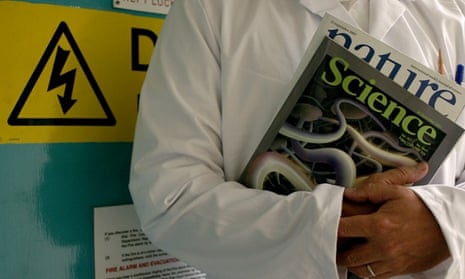The science journal Nature will make its archive of papers, dating back to 1869, free by way of read-only links available to subscribers and major news outlets.
Under the new system, planned as a one-year trial, subscribers such as universities and researchers will be able to share a link to a read-only version of a Nature paper with anyone. A platform called ReadCube will allow the recipient to read the paper but not copy, download or print it, thus allowing Nature’s publisher, Macmillan, to retain some control and act as intermediary. Some 49 journals under Nature’s auspices will be available through the system.
A hundred major media organizations and science blogs, including the BBC, the Guardian and the New York Times, will also be able to supply links to relevant Nature papers in stories, from the behavior of leopard seals to the chemical makeup of comets. These links will take the reader to ReadCube and a read-only view of the original paper, which they can also annotate. Only subscribers and media outlets will be able to create links to papers, but these can be shared on social media.
Implicitly acknowledging the problems of tightly controlled access, Nature chief executive Steven Inchcoombe said in a statement: “We know researchers are already sharing content, but not always optimally.” Timo Hannay, managing director of Digital Science, said: “We know researchers are already sharing content, often in hidden corners of the internet or using clumsy, time-consuming practices.”
Together, the comments frame the initiative as a compromise between the status quo of restricted access and the open access movement in favor of largely unfettered availability. Most scientific and scholarly journals charge exorbitant fees to subscribe or download papers, keeping studies largely within the hands of the universities and hospitals who can afford them.
But a world of “dark sharing” – so-called because journals lose sight of a paper as soon as someone downloads it – emerged alongside the internet, as researchers eager to share their work privately did so, and interested readers helped spread free copies of papers by way of DropBox and Pdf files. The ReadCube platform, in which Macmillan has invested, lets the publishers track readers and in part curtail unmonitored sharing.
Critics are calling Macmillan’s strategy “beggar access”, saying it changes little about papers’ availability. Phylogenetics researcher Ross Mounce writes in a blogpost that the new system simply formalises public sharing without making real reforms. Bonnie Swoger, writing a post for Scientific American (a Nature property), similarly suggests that ReadCube could actually represent even more control for publishers:
Open Access advocates stress that OA is not just about access, but about the ability to re-use the content in multiple ways. This new initiative from Nature is limiting even the most basic re-uses of this material: printing and saving. In the future, could publishers refuse to allow anyone (even subscribers) to download or save copies of the articles? Offline access would disappear, and content would become more difficult to use.
The open access movement pushes for something altogether more radical: free papers available on online archives. Open access sites vary in the terms, some charging processing fees and ensuring author rights, but have existed online for at least 20 years. Physicists have used sites such as Cornell’s arXiv since 1991 to let peers critique unfinished papers, for instance, and the US National Library of Medicine created PubMed for medical papers in 1997. Funding, peer review, and conflicts of interest – thorny issues for established publishers – loom as even larger challenges for open access advocates.
Inchcoombe insisted to Scientific American that Nature has taken a step forward, despite uncertainty over how the step will affect its business. “Our job as publishers is to serve the scientists and not to hobble progress,” he said. “When you’ve taken responsibility for disseminating information, you’ve taken on an obligation that needs to be balanced with making sufficient money.”
“Then we can all get what we are after – the authors, the readers, users, and sharers, and purchasers – everyone can win.”

Comments (…)
Sign in or create your Guardian account to join the discussion